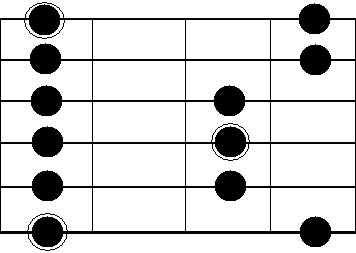Blues Guitar Jam Mini-Course Lesson 5:
How To Play Lead Guitar Solos At a Blues Jam Session
Now that you know which chords can be used to play at a blues jam, let’s look at playing blues solos. The notes that you use in lead guitar parts are always derived from scales, so that’s where we’ll start of with in today’s lesson.
Let us say that we are jamming a blues in the key of A. In that case we would be using the following chords: A7, D7, and E7 (as you learned in one of the previous lessons). First, you need to know which scales you can use, and also exactly how to use these scales. The manner in which we ‘decorate’ our scales is called ‘phrasing’, which we’ll look at in a second.
How To Know Which Scales You Can Use In a Blues Jam
Knowing which scales you can use is pretty easy; I am just going to tell you. The easiest scale to use over these chords, as you might be aware of, is the A minor pentatonic scale. This is the scale that most beginner blues guitarists start off with.

5 8
A minor pentatonic scale (box position)
It is arguably not the best scale to use, especially if your solely relying on this scale, but it has some great advantages when you are just starting out on the guitar. For this lesson, the purpose is not to look at all of the possible scales we could be using, but use the A minor pentatonic scale as an example that’s easy to understand and apply.
When we are playing a blues in A, we could be using this scale. But when you’re starting out, you would probably be interested in knowing exactly how you could use this scale. When you first encouter a new scale then you’ll probably have no clue how to use it musically and you are just playing the scale from the lowest note to the highest note or in a very random order.
It is a fairly difficult challange to overcome in the beginning of your guitar education to sound as ‘interesting’ as the blues guitarists you hear on your favorite albums. So what’s the solution here? For most guitarists, when they are stuck in their lead guitar progress, that’s about the time they learn about something called ‘guitar phrasing’.
Phrasing is the way in which we use the guitar (or any other musical instrument), to decorate the notes that you choose.
Phrasing also deals with ‘note choice’ (exactly which notes you play at what time for maximum expressiveness and impact on the listener) and it is also about how you put feeling to your guitar solos. The good news is that phrasing can be learned step by step with various learning approaches.
Phrasing Exercises
In this article we will be looking at one exercise specifically. In this first exercise, you will use just four random notes out of the A minor pentatonic scale. After you’ve determined which four notes you want to use, we’re going to apply guitar techniques to these notes.
Apply, for instance, a slide to one of the notes or you could use a hammer-on or pull-off technique. Also using a string bend or vibrato technique is a very expressive way to make these four notes “come to life”.
Listen here to 4 random notes of the A minor pentatonic scale
Listen here to these same notes but with applied techniques
Transposing Scales On The Neck Of The Guitar
Secondly, it is important to learn to transpose these scales. For instance, if you are playing a blues in B (instead of the blues in A example we’ve just used) at a jam session, then it is important to know which scales would fit over the blues in B progression. If you are playing a blues in the key of B, you would use the B minor pentatonic scale by transposing the A minor pentatonic scale two frets higher. You will be using the same fingerings for that, just two frets higher on the neck of the guitar, as you will see in the scale diagram below.

7 10
B minor pentatonic scale (box position)
The same applies to when you want to play for instance a blues in F, you would just shift everything to the 1st fret on the low E string.
Now that you know how you can play lead parts at a jam session, we are going to look in the next lesson at exactly how you can really stand out from the crowd when you are playing a jam session, even when you do not have any experience playing at such a jam. There are a couple of hacks and tricks you can use to make the audience believe that you have a lot of experience in playing at such a jam session. So look out for tomorrow’s lesson in your email inbox.
Learn about The Essential Blues Guitar Soloing Lesson
